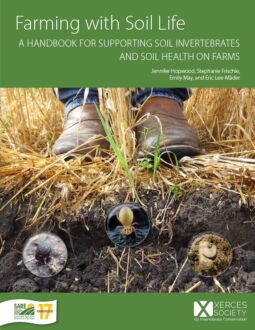INSECTS: CLASS INSECTA includes a great number of insect orders that dwell in the soil for all or a portion of their life cycle or that are involved in soil food webs, including all of the most diverse groups (e.g., beetles, flies, bees, wasps, ants, butterflies, and moths). These insects are important predators, root feeders, modifiers of soil structure, or decomposers.
FLIES (DIPTERA) are the only group of winged insects that have just one pair of wings. Adults usually have sponging or tubular mouthparts but never chewing mouthparts. Fly larvae are legless. Many flies are soil insects for one or more stages in their life cycle; at least 75 out of the 108 families of flies found in North America are part of soil systems. Fly larvae make considerable contributions to soil communities as decomposers of plant material or carrion and as predators or parasites; a number of flies pupate in the soil.
Nonbiting midges
PHYLUM: Arthropoda » CLASS: Insecta » ORDER: Diptera » FAMILY: Chironomidae
SIZE: 0.059–1.18" (1.5 mm–3 cm).
ECOLOGICAL ROLE: These larval flies are decomposers, helping to recycle plant debris.
DESCRIPTION: Larvae are legless but have two fleshy prolegs behind the head. Many adults are small and resemble mosquitoes without biting mouthparts, and their wings have no scales. Adult males have feathery antennae.
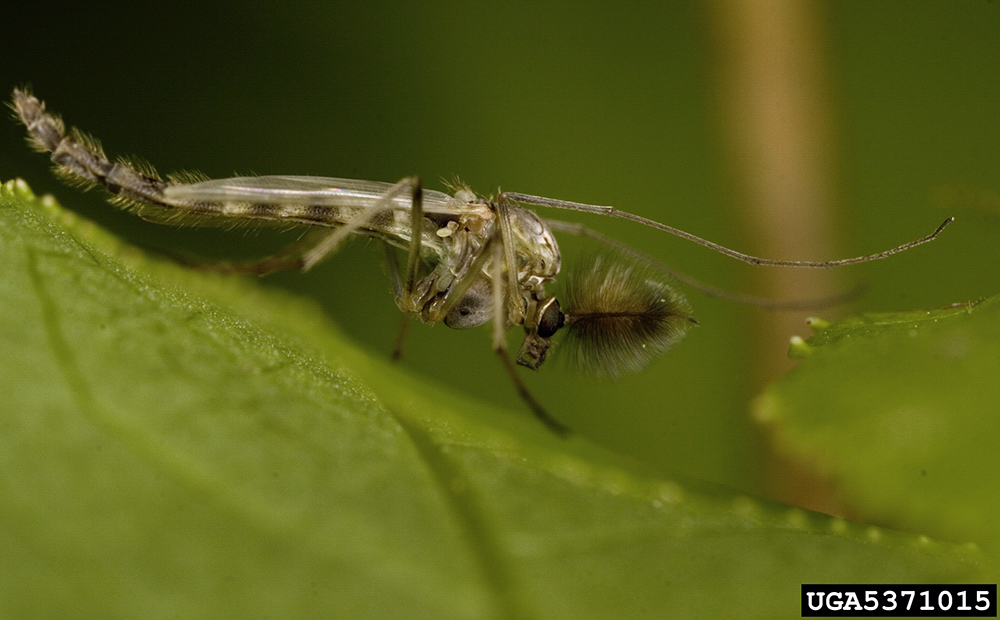
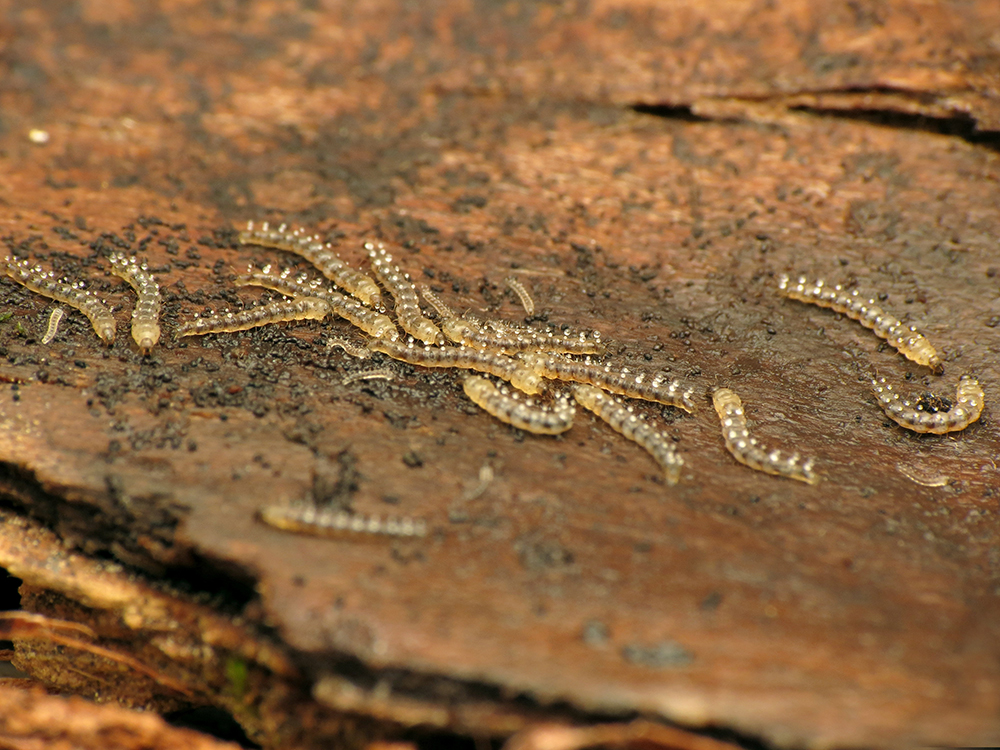
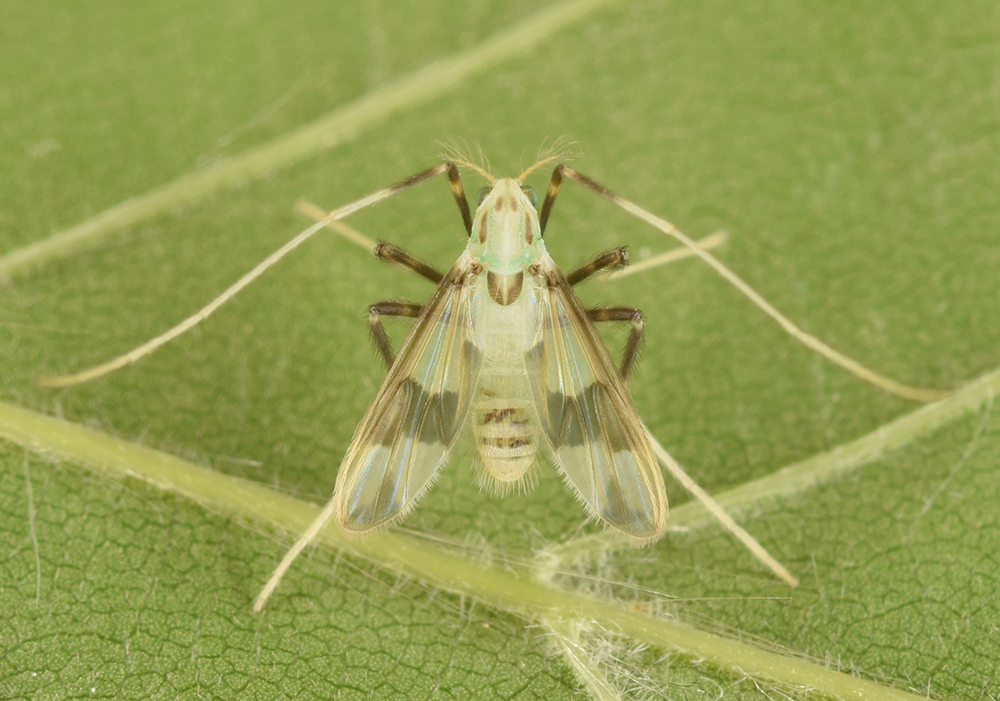
WHERE THEY ARE FOUND: Larvae of soil-dwelling species occur in decaying matter and soil, or under bark (many in this family are aquatic). Adults swarm in clouds near their larval habitat.
WHAT THEY EAT: Larvae eat detritus, algae and fungi; a few are predators or parasites. Adults either do not feed or consume pollen, nectar or honeydew.
LIFE CYCLE: Nonbiting midges lay eggs in soil. The time from egg through larvae and pupae to adult ranges from a week to a year or more, depending on the species. Adults are short lived.
APPROX. NUMBER OF KNOWN SPECIES: 7,000 worldwide (2,000 in North America).
RELATIVE ABUNDANCE: Larvae can be very abundant—as high as 10,000 per square meter—and are important food sources for fish and other animals.
NOTES OF INTEREST:
- The larvae of aquatic nonbiting midges are indicators of water quality; some species are found only in unpolluted waters, while others can live in polluted streams.
- Nonbiting midge larvae wiggle through soil using their two prolegs and spines for traction
March flies
PHYLUM: Arthropoda » CLASS: Insecta » ORDER: Diptera » FAMILY: Bibionidae
SIZE: 0.24–0.98" (6 mm–2.5 cm).
ECOLOGICAL ROLE: These decomposers help make humus by consuming fallen leaves.
DESCRIPTION: Adults have dark bodies, some with a red or yellow thorax, and lots of short bristles all over their bodies. Larvae are blackish-brown, have rows of fleshy projections covering their bodies, and have chewing mouthparts.
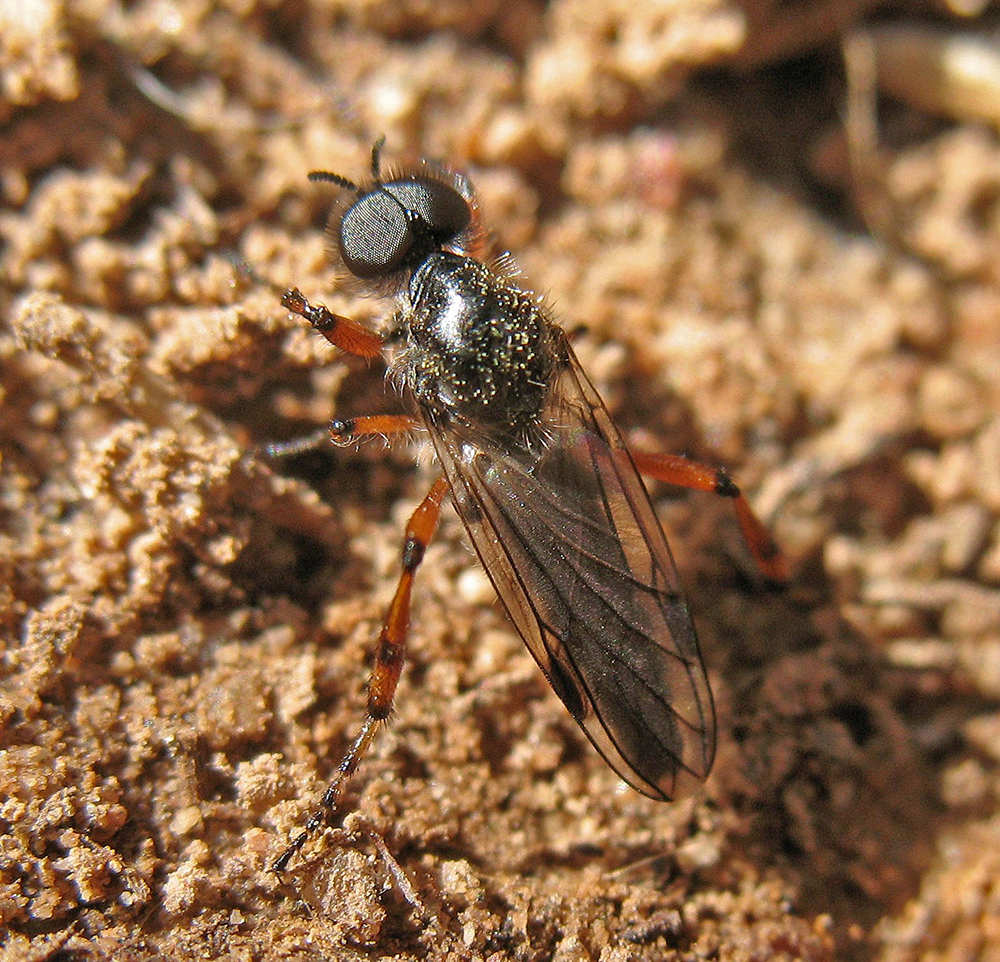
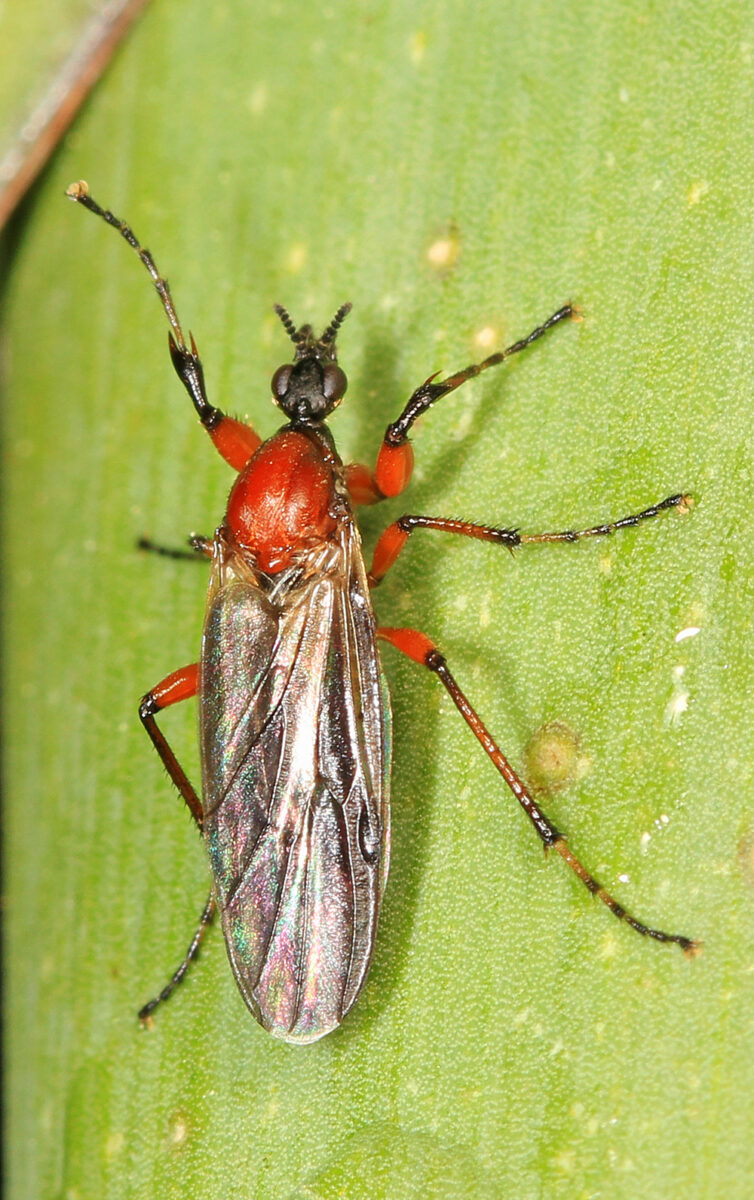
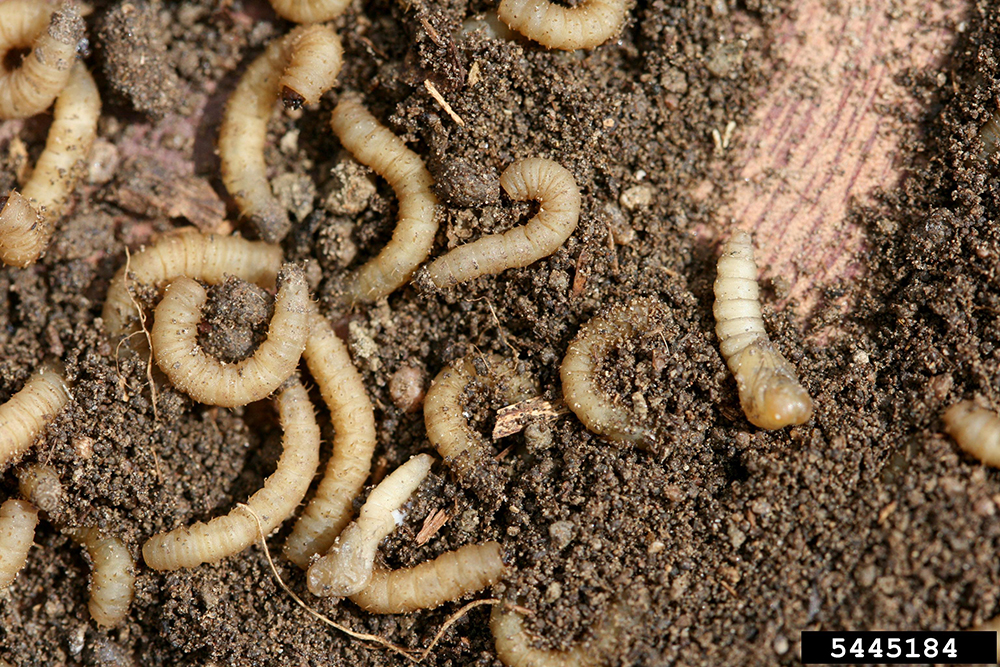
WHERE THEY ARE FOUND: Larvae live in decaying organic matter like leaf litter or dung, or they live among plant roots. Adults tend to fly in spring or summer and can be seen on flowers.
WHAT THEY EAT: Larvae feed preferably on decaying leaves, and they also consume fungi, algae, detritus or plant roots. Adults may drink nectar.
LIFE CYCLE: Adults emerge in masses and are short-lived. Females fly into swarms of males to find a mate, and paired flies stay attached to their mates for a day or more. Females dig a small chamber in the soil to lay their eggs.
APPROX. NUMBER OF KNOWN SPECIES: 1,100 worldwide (60 in North America).
RELATIVE ABUNDANCE: These flies can be very abundant, with 3,000 to 12,000 larvae per square meter.
NOTES OF INTEREST:
- Lovebugs (Plecia nearctica) are abundant in the southern United States. In Florida, mass emergence of adults can be a nuisance for drivers.
Crane flies
PHYLUM: Arthropoda » CLASS: Insecta » ORDER: Diptera » FAMILY: Tipulidae
SIZE: 0.12–2.36" (3 mm–6 cm).
ECOLOGICAL ROLE: Crane fly larvae make notable contributions to the decomposition of leaf litter, particularly in woodlands.
DESCRIPTION: Crane fly larvae are cylindrical and soft bodied with fleshy projections on their posterior; they have rasping jaws, and their head can be retracted into their thorax. Adults have very long, spindly legs and long beaks, and they are often mistaken for large mosquitoes.
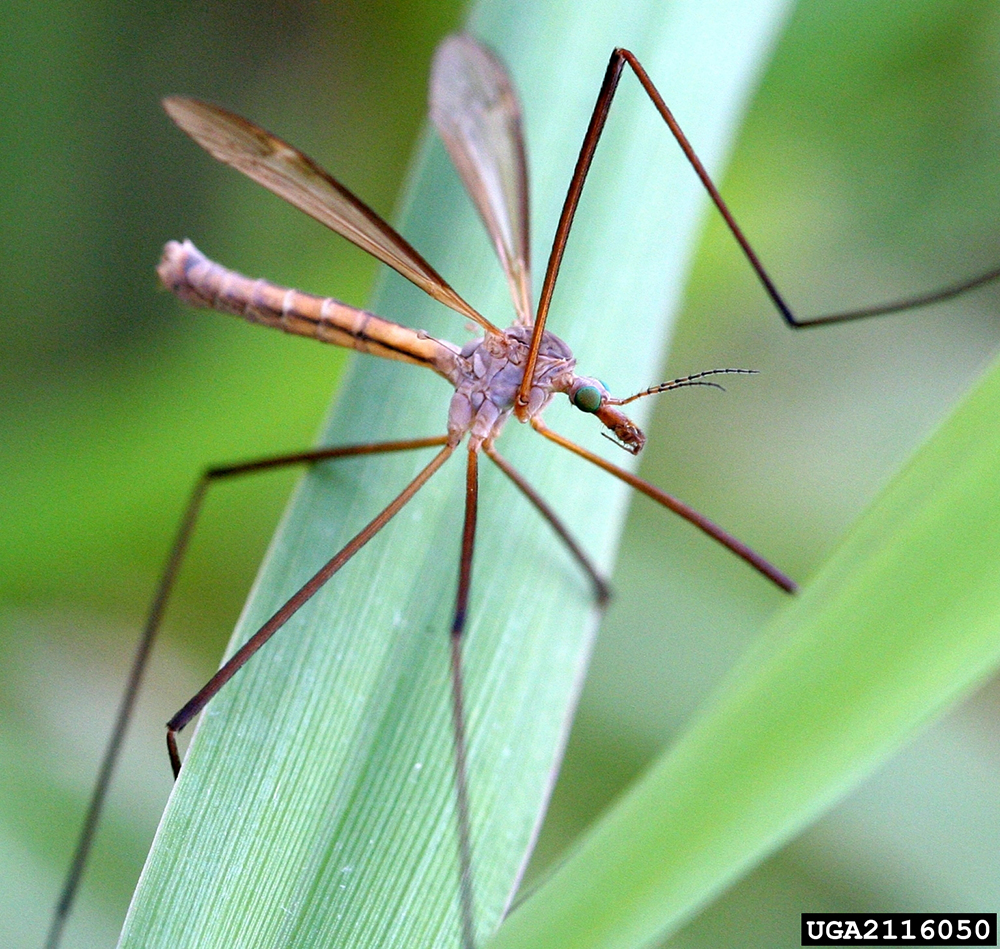
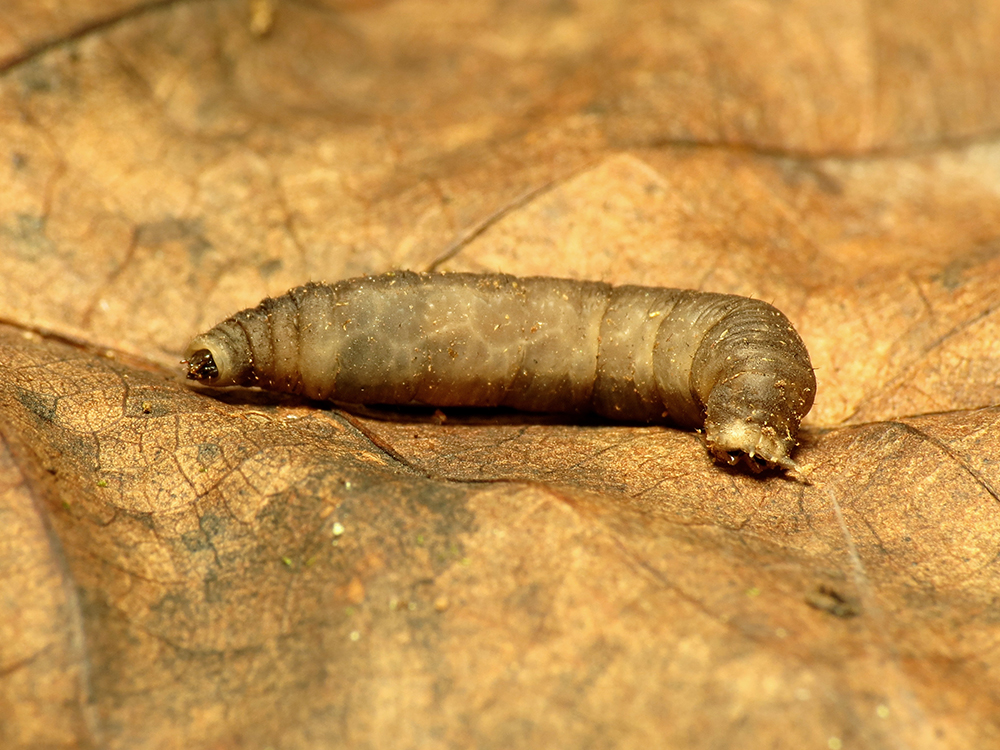
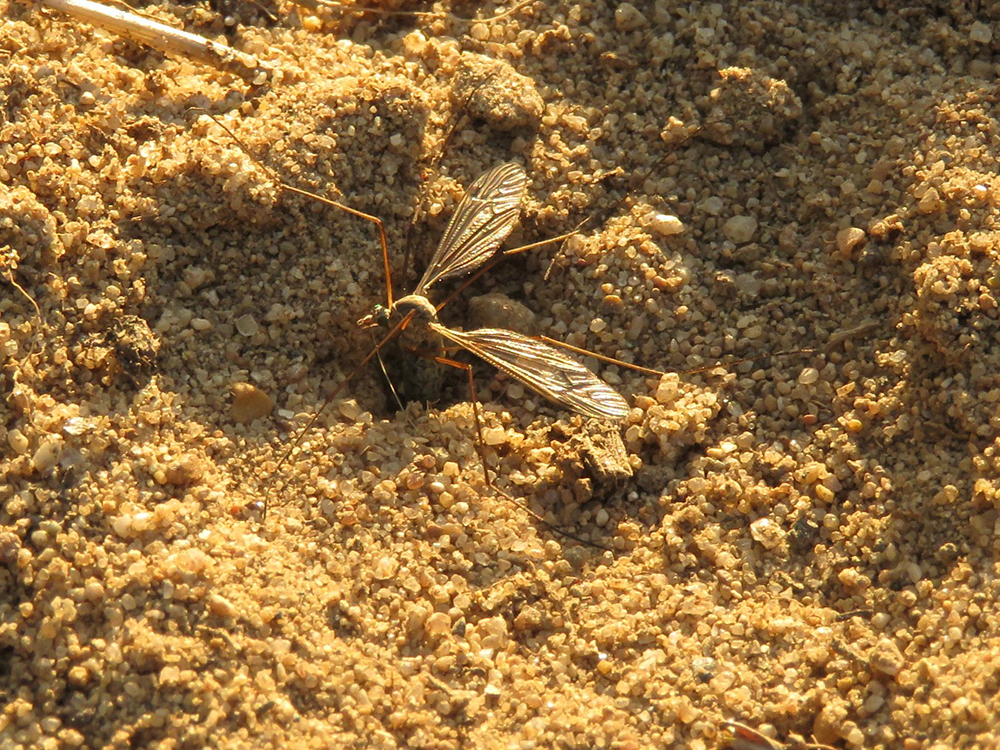
WHERE THEY ARE FOUND: Crane fly larvae are found in moist soils or leaf litter, particularly in forests but also along the shores of ponds and rivers, in moss or fungi, and under bark or in decaying wood. Adults may be seen on flowers but may be most visible near lights at night.
WHAT THEY EAT: Larvae eat detritus, algae, and fungi, and some feed underground on plant roots or eat other insects. Adults of some species drink nectar or sap, but many don’t feed as adults.
LIFE CYCLE: Crane flies lay eggs in the soil and overwinter as larvae. Adults emerge after pupation and fly for several weeks. Crane flies usually have one generation a year.
APPROX. NUMBER OF KNOWN SPECIES: 15,000 worldwide (1,500 in North America).
RELATIVE ABUNDANCE: Larvae of these flies can be very abundant.
NOTES OF INTEREST:
- Chionea crane flies do not have wings (but still have their halteres, knobbed appendages unique to flies, located in place of hindwings that help flies to rotate and balance) and can be seen walking on the snow on warm winter days.
- Contrary to urban legend, crane flies are neither giant mosquitoes nor do they eat mosquitoes; the few adult crane flies that feed have fly mouthparts suited only for occasional nectar.
Soldier flies
PHYLUM: Arthropoda » CLASS: Insecta » ORDER: Diptera » FAMILY: Stratiomyidae
SIZE: 0.2–1.4" (5–35 mm).
ECOLOGICAL ROLE: In soil food webs, these flies are primarily decomposers as larvae. Adults may contribute to plant pollination.
DESCRIPTION: Larvae have segmented bodies that are rough and leathery, helping them survive droughts in the summer. Adults are often colorful, and some mimic wasps and bees. Some have a broad, flattened abdomen and fold their wings flat over their backs.
WHERE THEY ARE FOUND: Larvae prefer soil with decaying plant matter. Adults are often found on flowers.
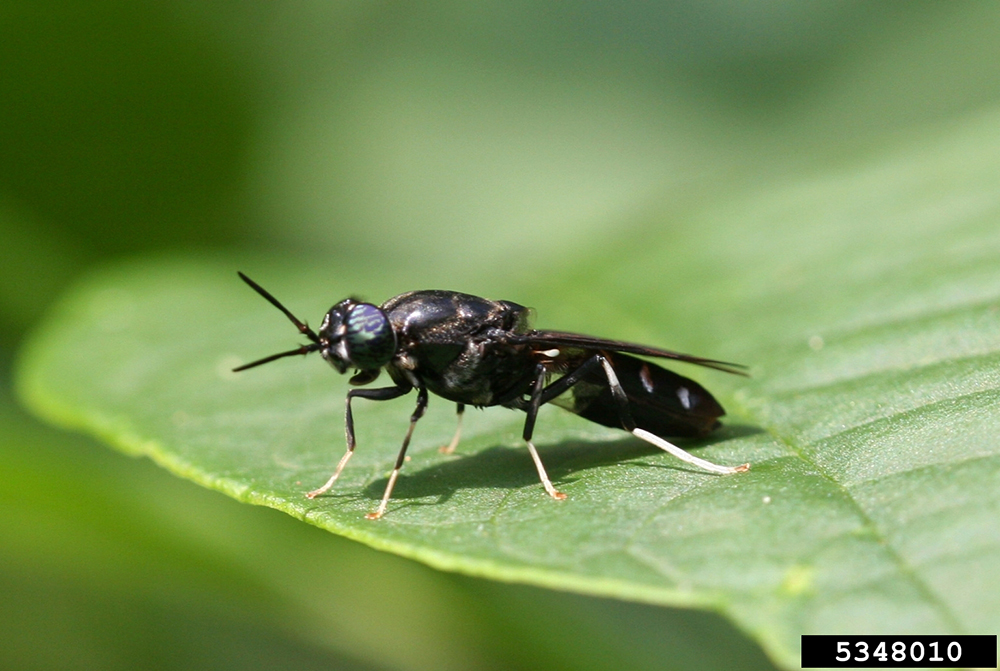
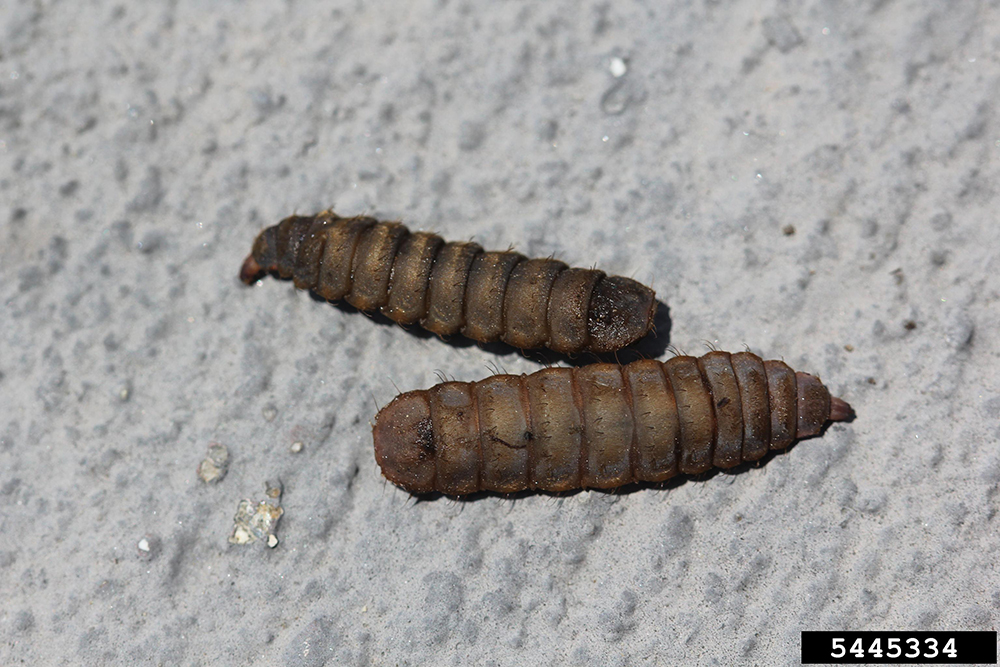
WHAT THEY EAT: Larvae eat detritus, soil algae, fungi and dung, and a few (in the subfamily Pachygastrinae) are predators of bark beetle (Scolytidae) larvae. Adults drink nectar.
LIFE CYCLE: Soldier flies deposit eggs near the larval food source (e.g., manure), and the larvae pass through several molts before pupation.
APPROX. NUMBER OF KNOWN SPECIES: 2,000 worldwide (250 in North America).
RELATIVE ABUNDANCE: Data unavailable.
NOTES OF INTEREST:
- Soldier fly larval skin contains calcium carbonate.
- The larvae of black soldier flies (Hermetia illucens) are a food source for many animals, and researchers are exploring them as a possible protein source for humans and livestock.
Snipe flies
PHYLUM: Arthropoda » CLASS: Insecta » ORDER: Diptera » FAMILY: Rhagionidae
SIZE: 0.24–0.59" (6 mm–1.5 cm).
ECOLOGICAL ROLE: Snipe flies are predators in soil food webs.
DESCRIPTION: Adults have rounded heads, large eyes and a long, tapering abdomen. Many have dark spots or patterns on their wings.
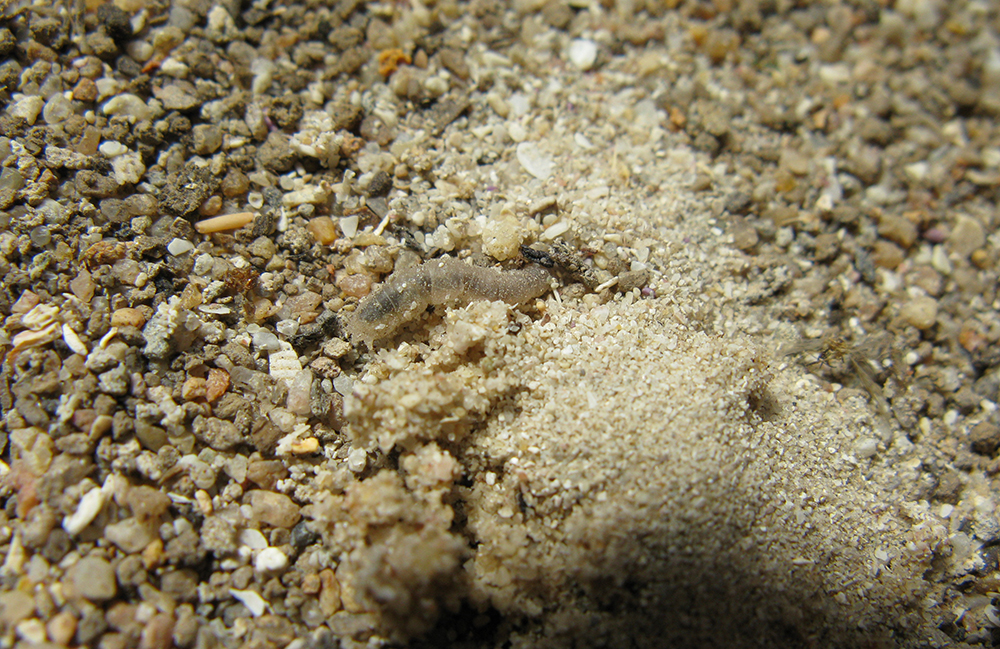
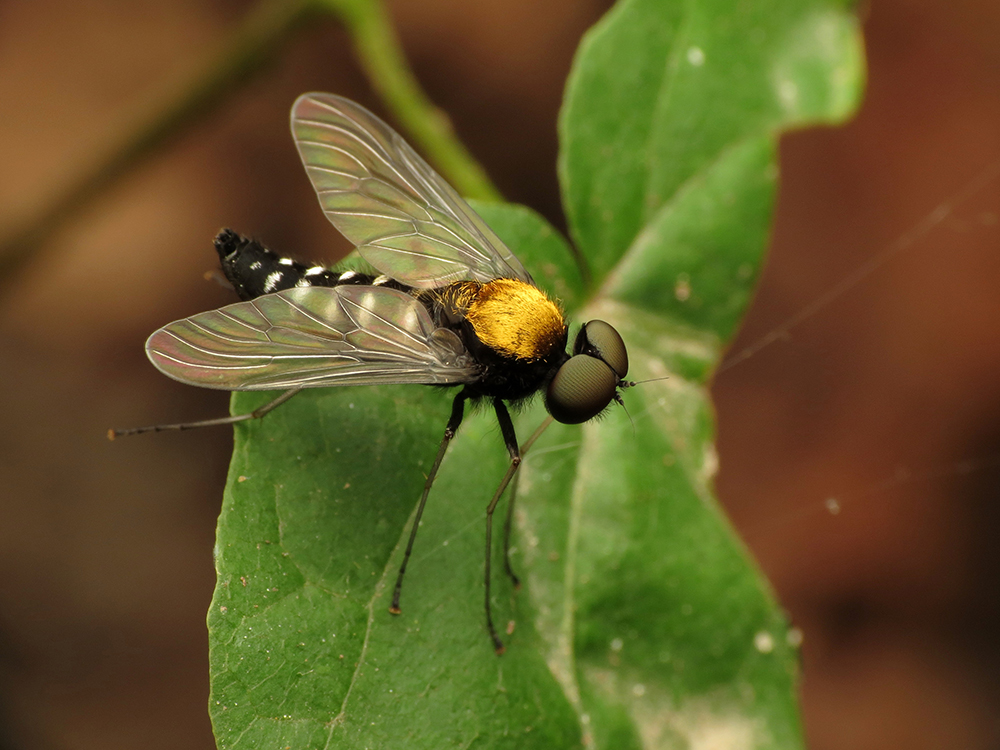
WHERE THEY ARE FOUND: Larva are found in leaf litter. Adults occur nearby, usually on foliage.
WHAT THEY EAT: Adults and larvae are predaceous on small insects. Adults perch on vegetation to catch their prey. Larvae strike at other soil insects from the leaf litter.
LIFE CYCLE: Snipe flies lay eggs in leaf litter. Larvae likely overwinter in the leaf litter and there is likely one generation per year. Adults emerge in late spring and early summer.
APPROX. NUMBER OF KNOWN SPECIES: 400 worldwide (100 in North America).
RELATIVE ABUNDANCE: Data unavailable.
NOTES OF INTEREST:
- Few snipe fly species bite people, but Rocky Mountain bite flies (Symphoromyia) do suck blood and can inflict bites on people across their range in the western United States.
Moth flies
PHYLUM: Arthropoda » CLASS: Insecta » ORDER: Diptera » FAMILY: Psychodidae
SIZE: 0.12–0.24" (3–6 mm).
ECOLOGICAL ROLE: Moth flies contribute to the decomposition of plant matter and fungi.
DESCRIPTION: Adults are hairy and mothlike, with long antennae, and they hold their wings like a roof over their body. Larvae are eyeless and legless, with hairs or bristles on their body. They can add chunks of soil to cover their backs, perhaps as camouflage.
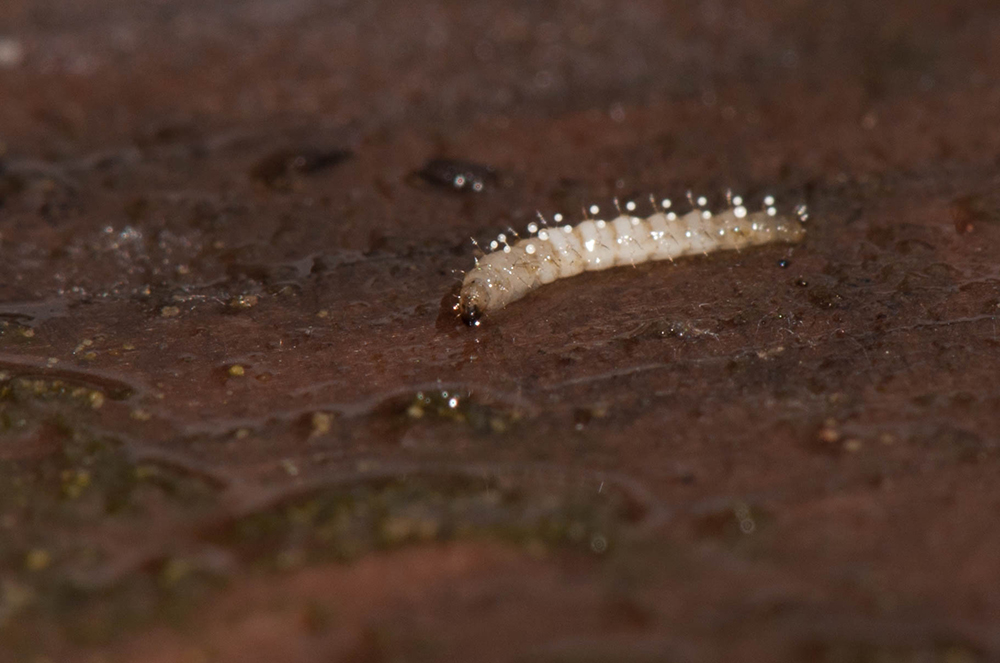
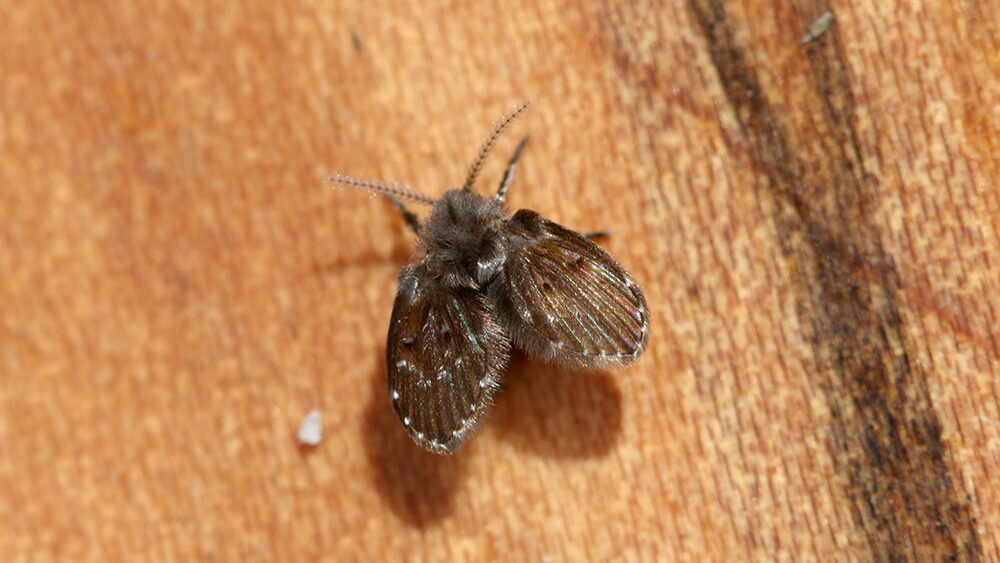
WHERE THEY ARE FOUND: Larvae are found in very moist woodland soil, decaying lea rotting logs, and moss, and several species are in streams. Adults occur in moist areas including drains in buildings and near sewers.
WHAT THEY EAT: Larvae and adults consume plant detritus, fungi, or algae.
LIFE CYCLE: Moth flies lay eggs in water films or wet soils. Development time from egg to adult can be as short as eight days or up to one month.
APPROX. NUMBER OF KNOWN SPECIES: 450 worldwide (115 in North America).
RELATIVE ABUNDANCE: Data unavailable.
NOTES OF INTEREST:
- Phlebotomine sand flies (Phlebotominae) suck blood and are found in the southern United States and tropics. They can transfer leishmaniasis, a disease caused by a protozoan parasite.
- Moth flies can sometimes be considered a nuisance if they breed in bathroom drains in buildings.
Signal flies
PHYLUM: Arthropoda » CLASS: Insecta » ORDER: Diptera » FAMILY: Platystomatidae
SIZE: 0.12–0.47" (3–12 mm).
ECOLOGICAL ROLE: Signal flies are herbivores or decomposers in soil food webs.
DESCRIPTION: Adults have brown or black wing markings and shiny, metallic bodies. Larvae are soft-bodied, cream in color, and have a small, hardened head.
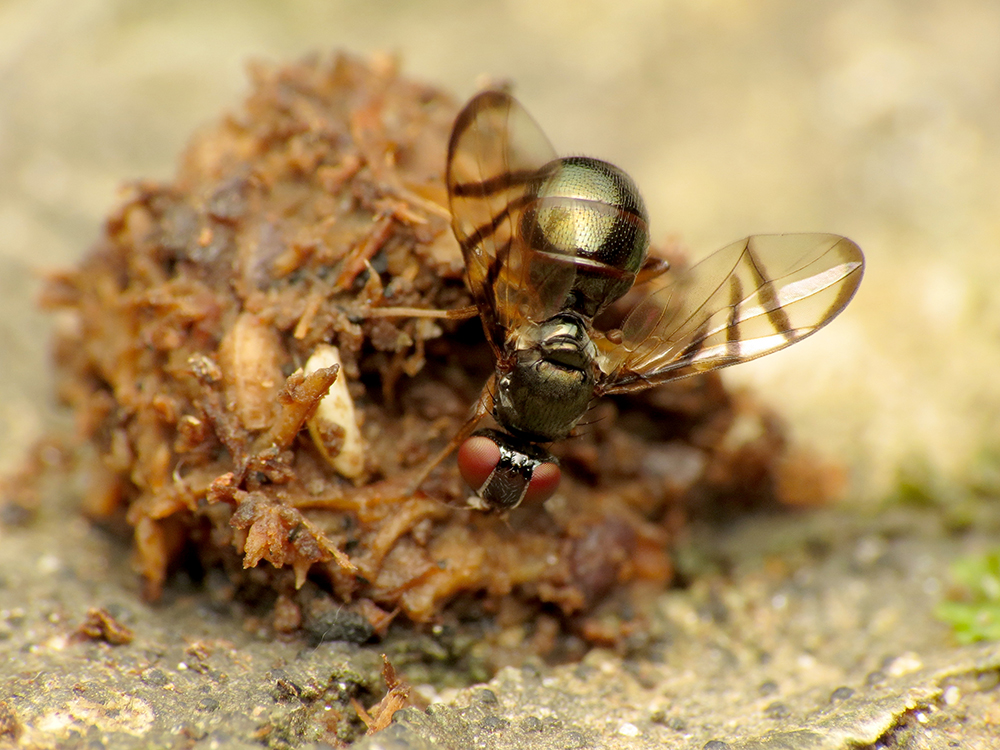
WHERE THEY ARE FOUND: Signal fly larvae occur in decaying vegetation. Adults are found on foliage or tree trunks.
WHAT THEY EAT: Some larvae eat root nodules, which contain nutrients as well as bacteria. Others are found on carrion and decaying vegetation. Adults may visit flowers, decaying fruit, or decomposing organic matter.
LIFE CYCLE: Signal flies deposit eggs near a larval food source. After they hatch, larvae must find the intended food nearby. Those that feed on root nodules, for example, must travel through the soil under plants to find nodules on which to feed. These flies likely overwinter as larvae, and there is likely only one generation of these flies each year.
APPROX. NUMBER OF KNOWN SPECIES: 1,100 worldwide (41 in North America).
RELATIVE ABUNDANCE: Data unavailable.
NOTES OF INTEREST:
- These flies are commonly called signal flies because their wings are in almost constant motion, flicking back and forth as though the flies are giving signals.
- Signal flies are among the few animals that utilize root nodules as a food source.
Blow flies, flesh flies and house flies
PHYLUM: Arthropoda » CLASS: Insecta » ORDER: Diptera » FAMILIES: Calliphoridae, Muscidae, Sarcophagidae
SIZE: 0.08–0.87" (2–22 mm) but usually 0.24–0.55" (6–14 mm).
ECOLOGICAL ROLE: Blow flies (Calliphoridae), flesh flies (Sarcophagidae) and house flies (Muscidae) can be decomposers of plant and animal matter in soil food webs, as well as predators or parasites. Some of these flies are of economic importance, causing harm to domestic animals or humans.
DESCRIPTION: Blow flies are green or blue metallic in color. Flesh flies are dark with gray stripes on their thorax. House flies are typically gray, brown, yellow or black in color.
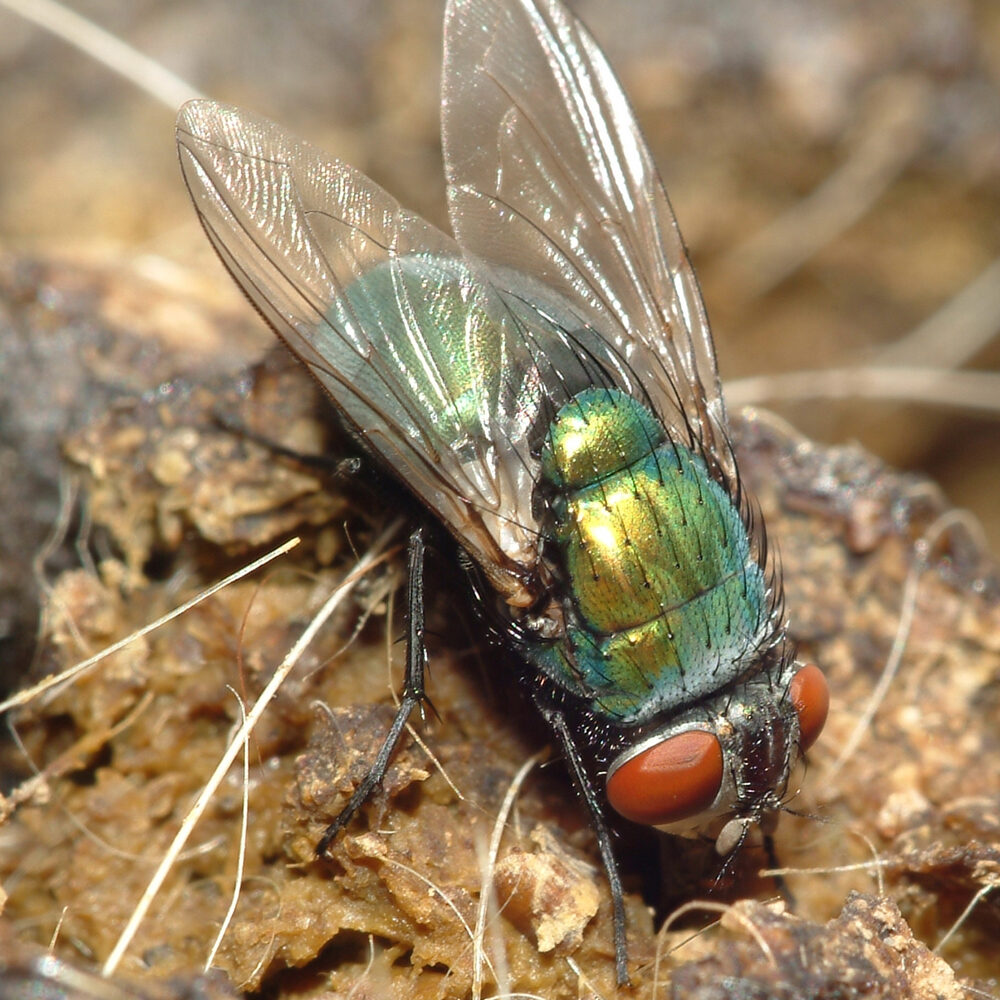
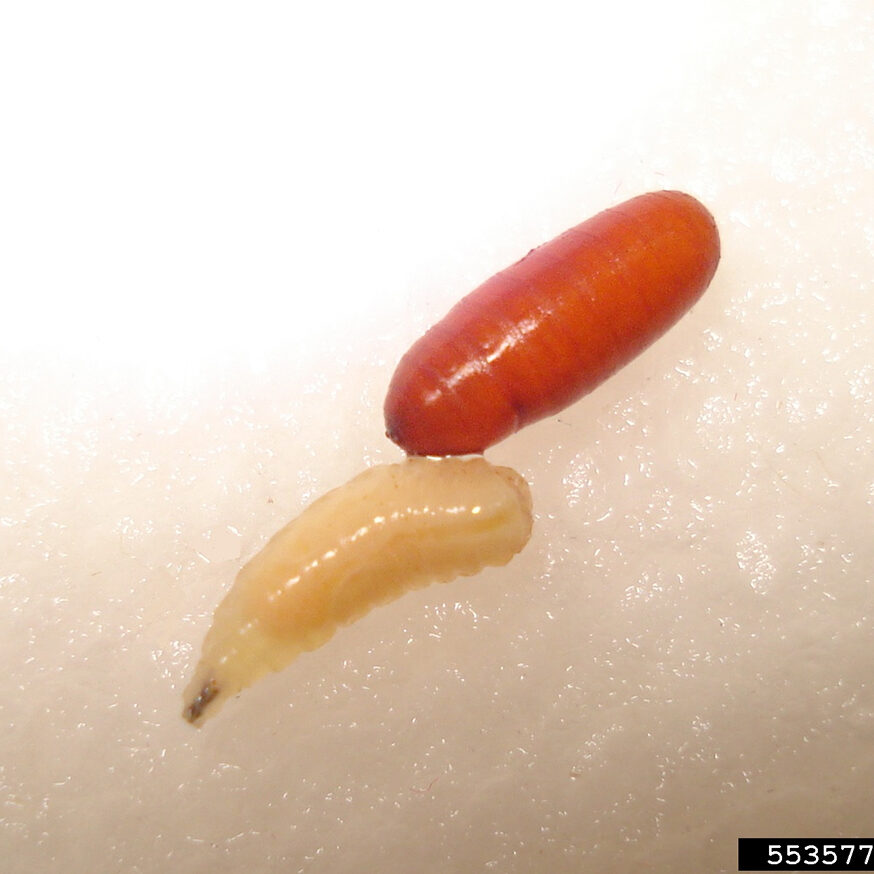

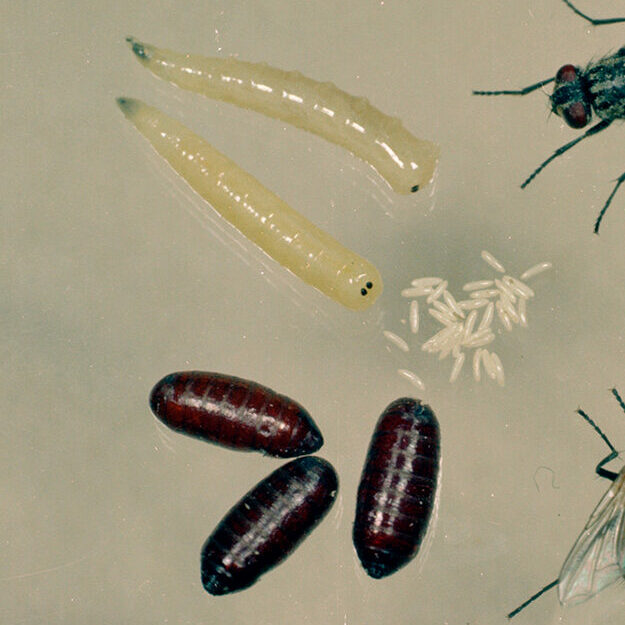
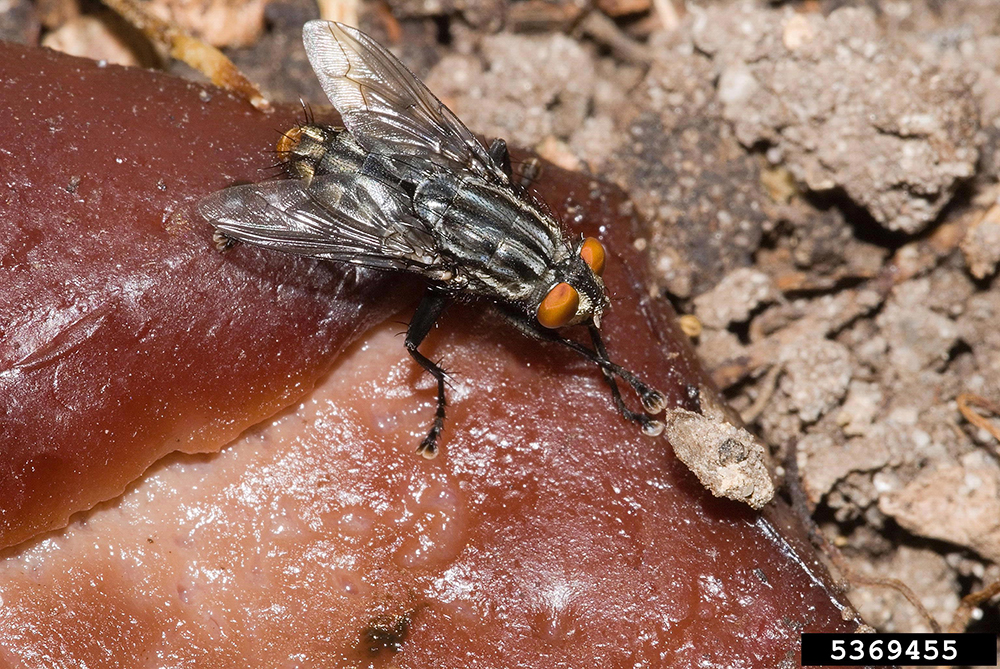
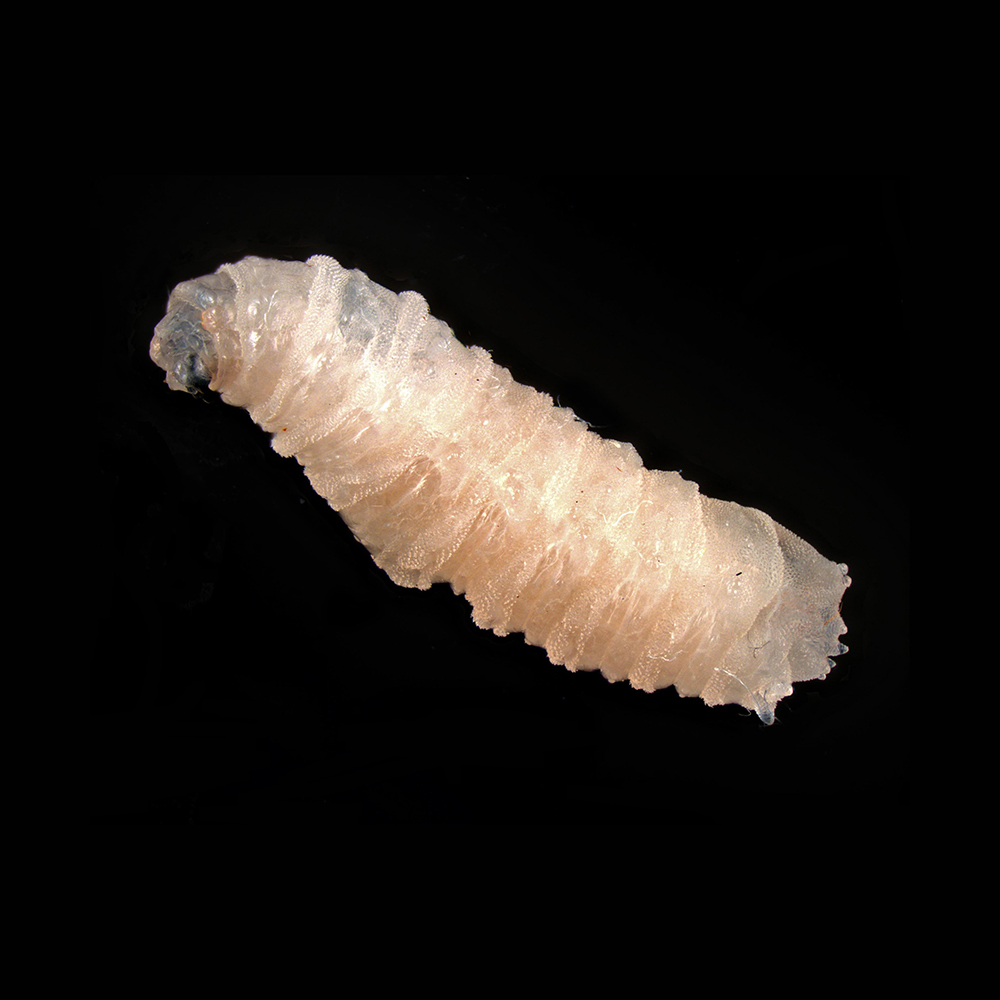
WHERE THEY ARE FOUND: These flies are common near decaying materials, including dung, feces and carrion. Some can be found parasitizing vertebrates.
WHAT THEY EAT: Larvae eat dung, carrion, decaying vegetation and living tissue of animals (e.g., feeding on flesh in an open wound on a horse); some are predators of other arthropods, earthworm and snails; and a few are parasitoids of other insects. Adults feed on nectar, sap, honeydew, fruit juices, or fluids from animal bodies or waste.
LIFE CYCLE: These insects lay eggs near a preferred food source, in either decaying matter or in living tissue. Life cycles can be completed in as little as a week.
APPROX. NUMBER OF KNOWN SPECIES: 1,500 blow flies worldwide (84 in North America), 3,100 flesh flies worldwide (400 in North America), and 5,200 house flies worldwide (700 in North America).
RELATIVE ABUNDANCE: These flies can be very common, especially near stables and on hog, poultry, or cattle farms.
NOTES OF INTEREST:
- Some species of house flies (e.g., Musca domestica) are vectors of pathogens harmful to humans (e.g., typhoid fever and dysentery). The horn fly (Haematobia irritans), also in the family Muscidae, breeds in cow dung and is a serious pest of cattle.
- The screwworm fly (Cochliomyia hominivorax), in the family Calliphoridae, lays its eggs in open sores or inside nostrils of its host.
- One group of flesh flies, species in the Sarcophagidae subfamily Miltogramminae, are cleptoparasites and develop in the nests of predatory wasps by feeding on the arthropods intended as food provisions for wasp young. Other flesh flies frequent pitcher plants, feeding on the insects drowned in the pitcher’s liquid.
Dance flies
PHYLUM: Arthropoda » CLASS: Insecta » ORDER: Diptera » FAMILY: Empididae
SIZE: 0.06–0.47" (1.5–12 mm).
ECOLOGICAL ROLE: Dance flies are decomposers and predators.
DESCRIPTION: Adults are dark in color with long, spiny legs.
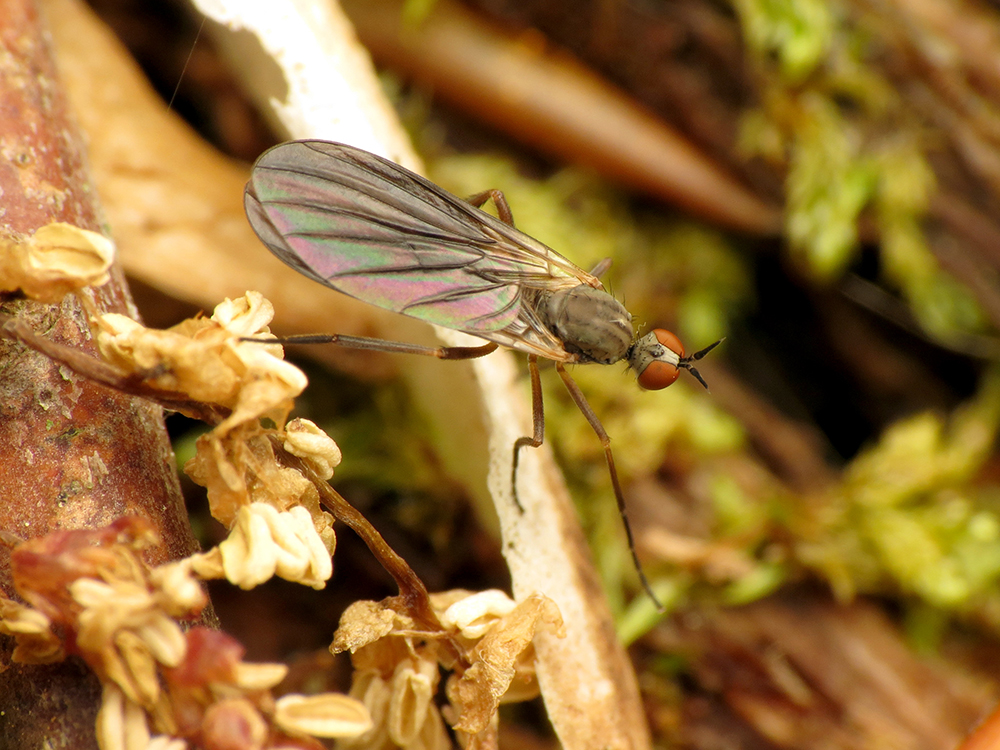
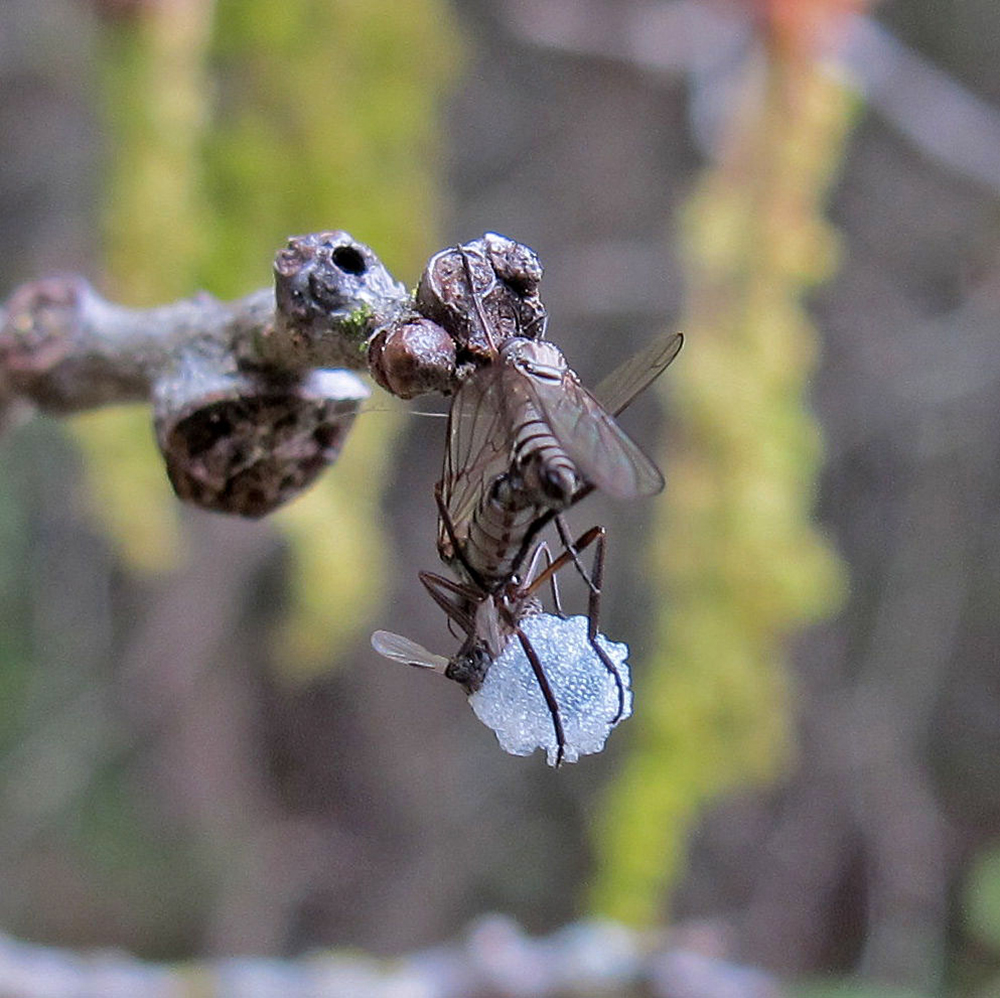
WHERE THEY ARE FOUND: Dance fly larvae live in soil, decaying vegetation, and under bark, and some are in dung or fungus. Adults swarm, flying up and down near larval habitat, and can also be found on flowers.
WHAT THEY EAT: Adults prey on a variety of other insects, including black flies (Simuliidae) and mosquitoes (Culicidae), and some drink nectar. Larvae eat decaying matter, and some are predators of other soil insects.
LIFE CYCLE: Females enter swarms of males to choose a mate. They lay eggs in soil or in decaying vegetation.
APPROX. NUMBER OF KNOWN SPECIES: 4,000 worldwide (725 in North America).
RELATIVE ABUNDANCE: Data unavailable.
NOTES OF INTEREST:
- Male dance flies provide nuptial gifts to attract females.
- This group of flies isn’t well studied, so there is much to learn about their natural history.
Long-legged flies
PHYLUM: Arthropoda » CLASS: Insecta » ORDER: Diptera » FAMILY: Dolichopodidae
SIZE: Less than 0.04–0.35" (1–9 mm).
ECOLOGICAL ROLE: Long-legged flies are predators in soil systems and above ground.
DESCRIPTION: Adults are small, with metallic green-blue-copper bodies and long legs.
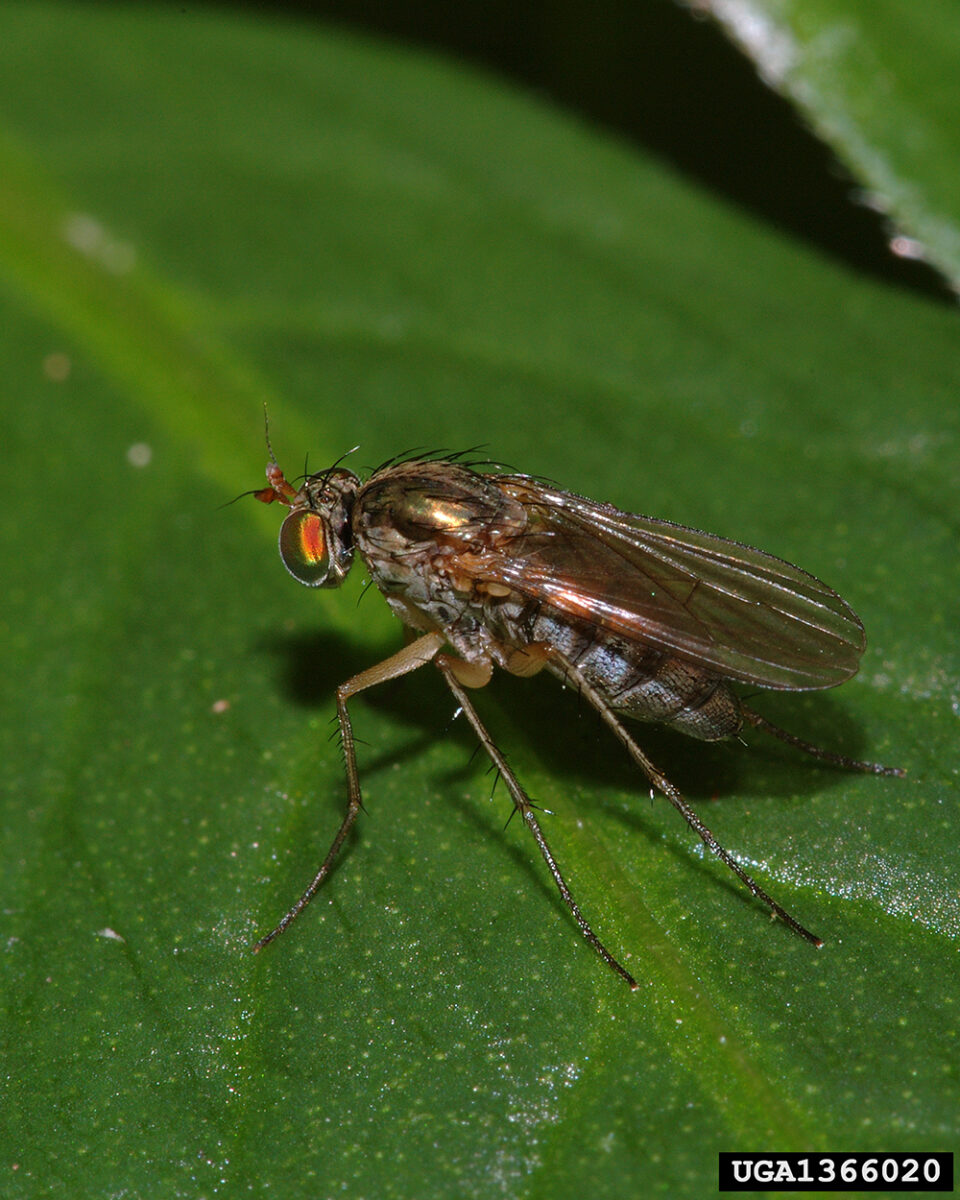
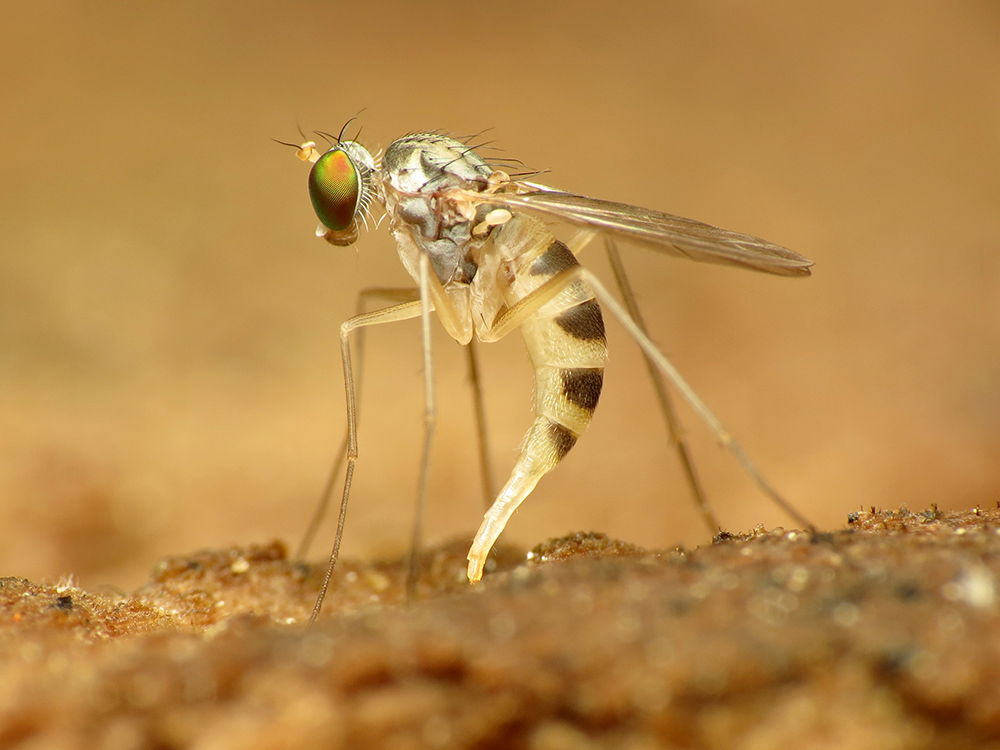
WHERE THEY ARE FOUND: Adults visit flowers. Larvae are found in decaying wood, leaf litter and moist soil, and some live in water.
WHAT THEY EAT: Adults prey on small insects. Larvae are predaceous on soft-bodied prey like springtails or scales, but their diets are not fully known.
LIFE CYCLE: Long-legged flies lay eggs in soil. Pupation occurs in the soil within cocoons of soil particles.
APPROX. NUMBER OF KNOWN SPECIES: 7,400 worldwide (1,300 in North America).
RELATIVE ABUNDANCE: These are very abundant flies, particularly in forests and meadows, and near streams.
NOTES OF INTEREST:
- Adult long-legged flies have elaborate mating dances.
- This group of flies isn’t well studied, and there is much to learn about their natural history.
Robber flies
PHYLUM: Arthropoda » CLASS: Insecta » ORDER: Diptera » FAMILY: Asilidae
SIZE: 0.3–1.4" (8 mm–3.5 cm).
ECOLOGICAL ROLE: Robber fly larvae are predators of other soil arthropods. In aboveground ecosystems, adults are predators of a wide range of insects.
DESCRIPTION: Larvae have soft bodies that are lo and tapered at both ends. They are white to transparent in color, have a hardened head, and may grow as long as 1" (2.54 cm). Adults have large eyes with a depression between them, short antennae, and long, sturdy legs with bristles used for capturing prey. Some species mimic bees to a striking degree.
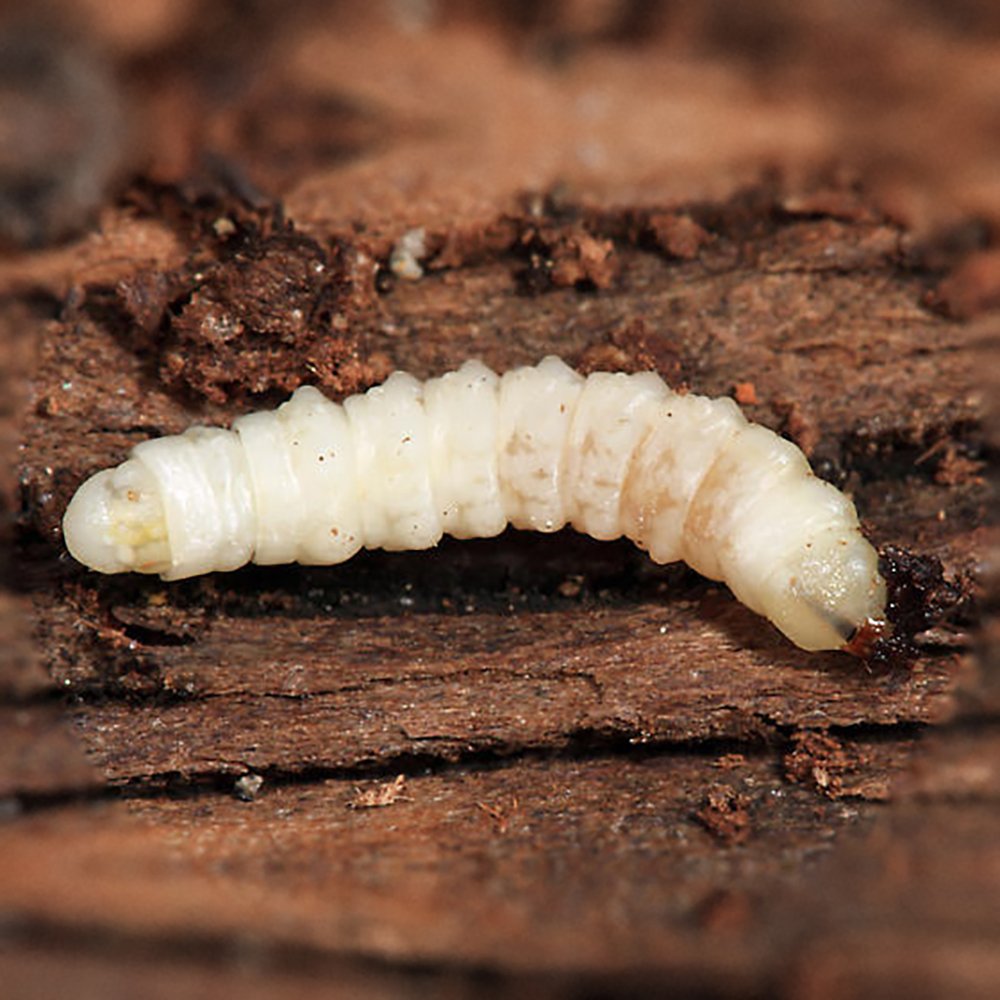
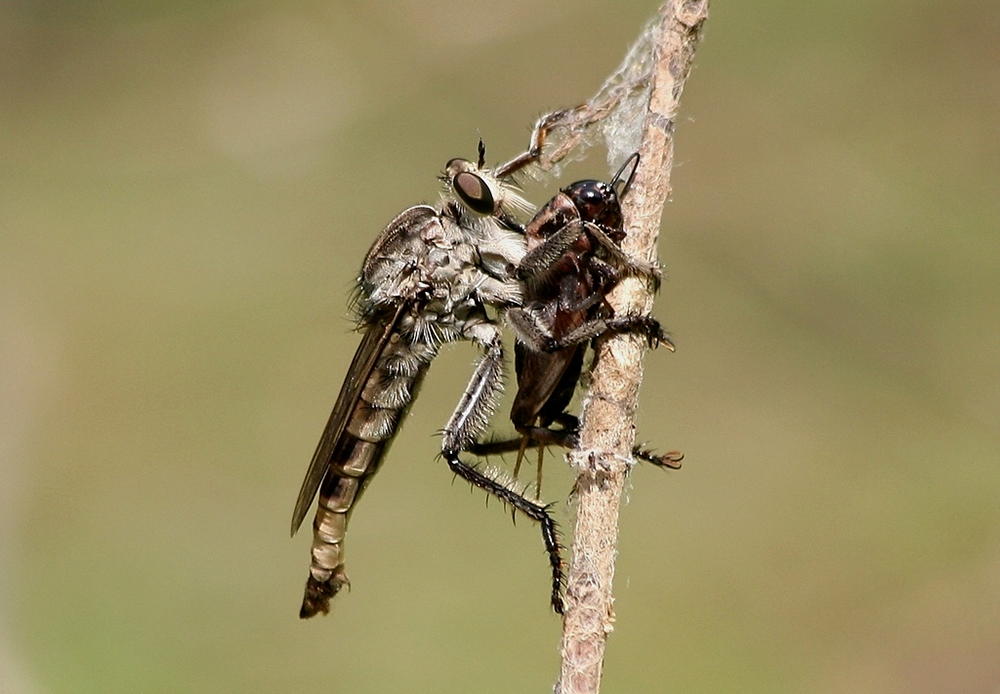
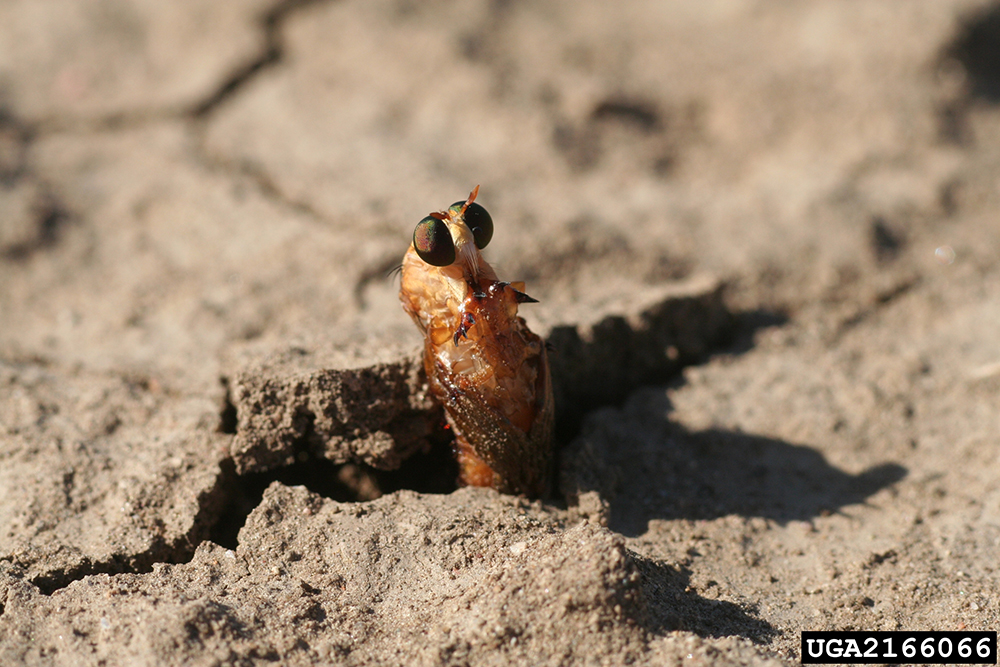
WHERE THEY ARE FOUND: Robber fly larvae live in the soil and litter, under bark, or in decayed logs. Adults are found on vegetation, where they are on the lookout for prey.
WHAT THEY EAT: Larvae consume insects in the soil, including beetle larvae (grubs) and grasshopper eggs. Adults capture other insects while in flight and are not selective—butterflies, bees, wasps, beetles, grasshoppers, flies and many more.
LIFE CYCLE: Robber flies usually deposit eggs in the soil, but some species lay eggs on decaying wood. They overwinter as larvae, and pupation occurs in the soil. Development can take up to three years.
APPROX. NUMBER OF KNOWN SPECIES: 5,000 worldwide (1,000 in North America).
RELATIVE ABUNDANCE: Data unavailable.
NOTES OF INTEREST:
- Adults can catch prey on the wing, including skilled fliers like bees, dragonflies, and more.
- Robber fly larvae have no legs but are still predators.
Bee flies
PHYLUM: Arthropoda » CLASS: Insecta » ORDER: Diptera » FAMILY: Bombyliidae
SIZE: 0.35–0.98" (9 mm–2.5 cm).
ECOLOGICAL ROLE: Bee flies are parasitoids of soil insects as larvae and can be pollinators of some wild plants as adults.
DESCRIPTION: Adults have fuzzy, stout bodies and are shaped like bees. They have a long, thin proboscis used for sipping nectar. Larvae have robust, soft bodies that are legless and tapered at both ends.
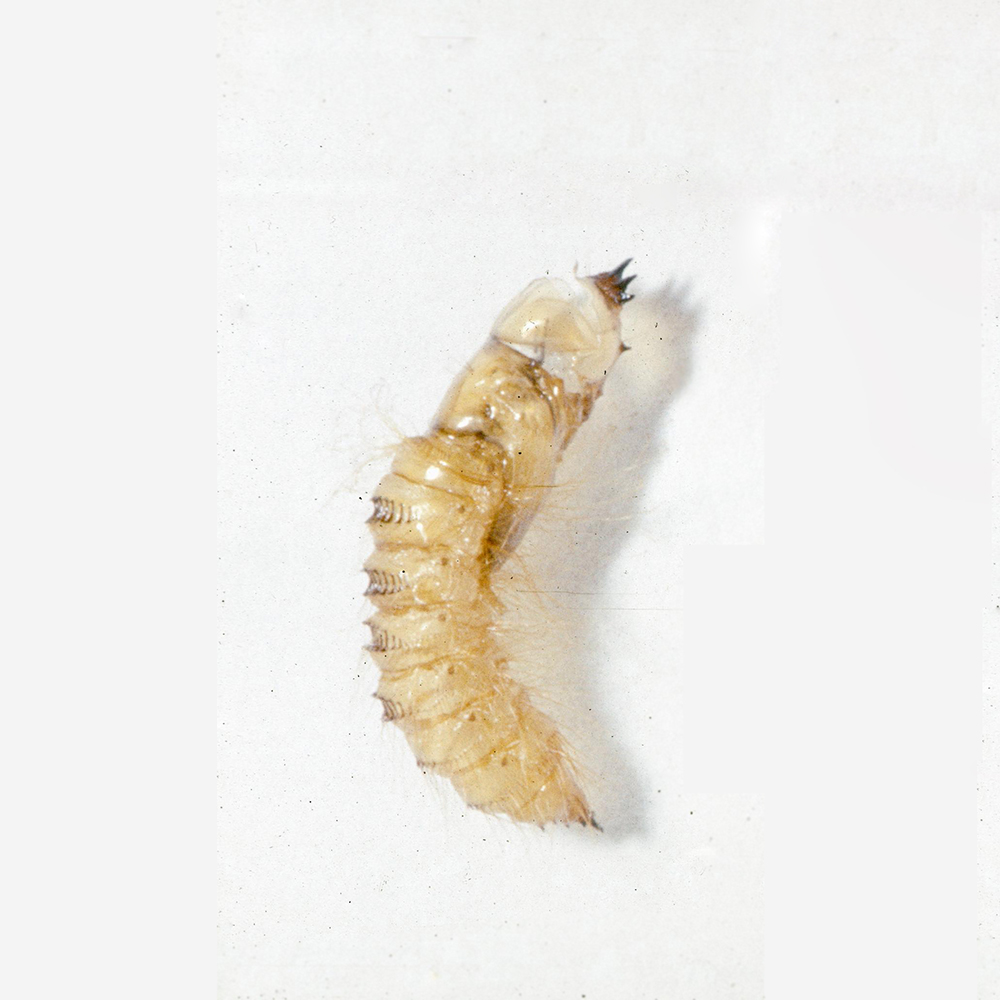
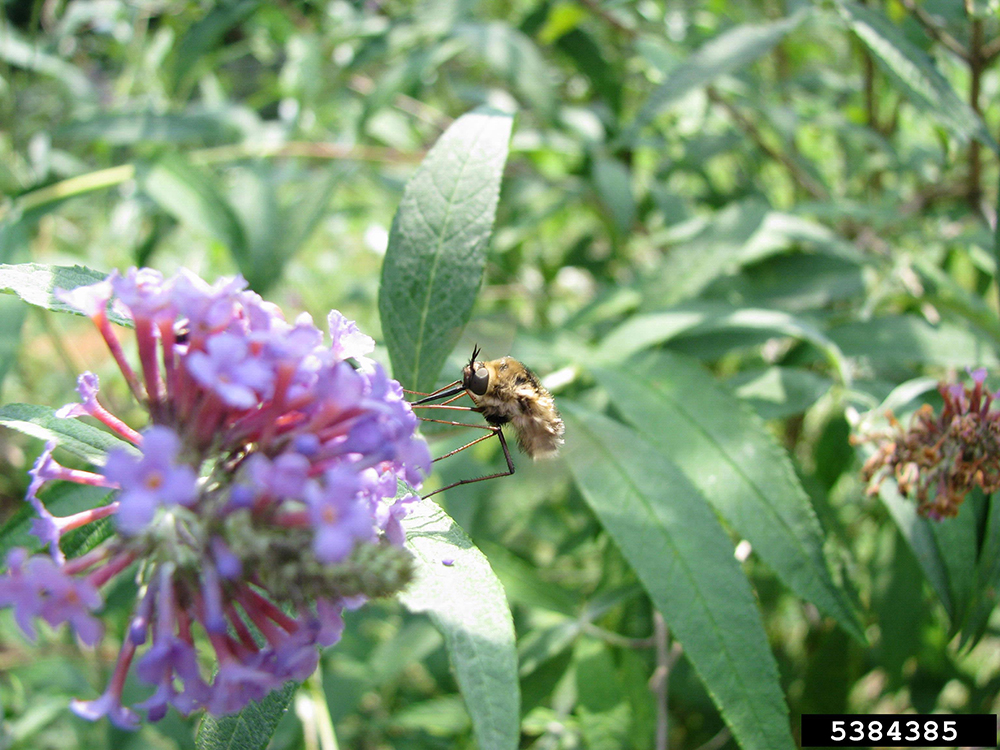
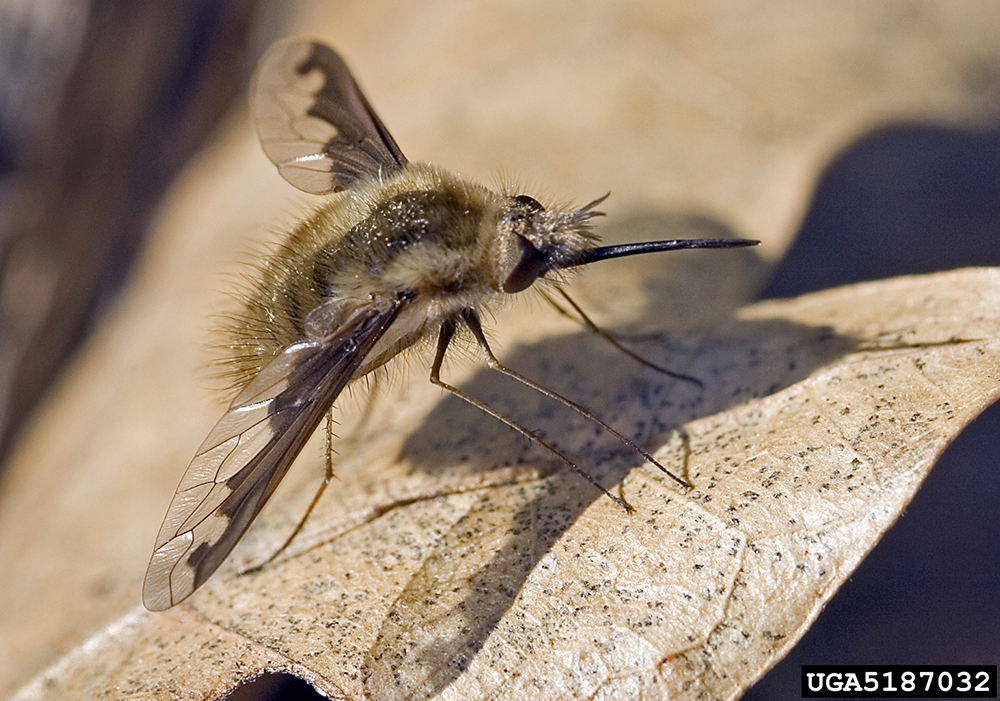
WHERE THEY ARE FOUND: Adults are found visiting flowers, hovering while they retrieve nectar. Larvae are found on their hosts in the soil.
WHAT THEY EAT: Larvae are parasitoids of insects in the soil, including grasshopper eggs; wasp, bee, beetle, and antlion larvae; moth caterpillars; and other fly larvae. Adults drink nectar.
LIFE CYCLE: Female bee flies deposit eggs in crevices in the ground near grasshopper eggs or other hosts, and the larvae must dig to find their host. The developing adult fly within its pupal case drills back out of the soil.
APPROX. NUMBER OF KNOWN SPECIES: 3,000 worldwide (800 in North America).
RELATIVE ABUNDANCE: Data unavailable.
NOTES OF INTEREST:
- Bee flies are some of the earliest pollinators to emerge in the spring and visit early-blooming plant species for nectar.
- Once larvae have found their host, they attach themselves with their mouthparts and suck out the body contents.
Flower flies
PHYLUM: Arthropoda » CLASS: Insecta » ORDER: Diptera » FAMILY: Syrphidae
SIZE: 0.3–0.78" (8–20 mm).
ECOLOGICAL ROLE: In the soil, larvae of some flower fly species are detritivores, helping to break down plant material or fungi, while other flower fly larvae are predatory, hunting small insects and arthropods. Adult flower flies are pollinators and are among the most effective group of non-bee pollinators of cultivated crops.
DESCRIPTION: Flower fly larvae are brown-gray-green, some with distinctive markings, stripes, or spines. Larvae are legless and swing their heads from side to side while hunting prey in leaf litter or on foliage. Adult flower flies have two wings; short, stout antennae; and large, broad eyes. Adults often have bright coloration, and many species mimic the coloration of bees or wasps, some to a striking degree.
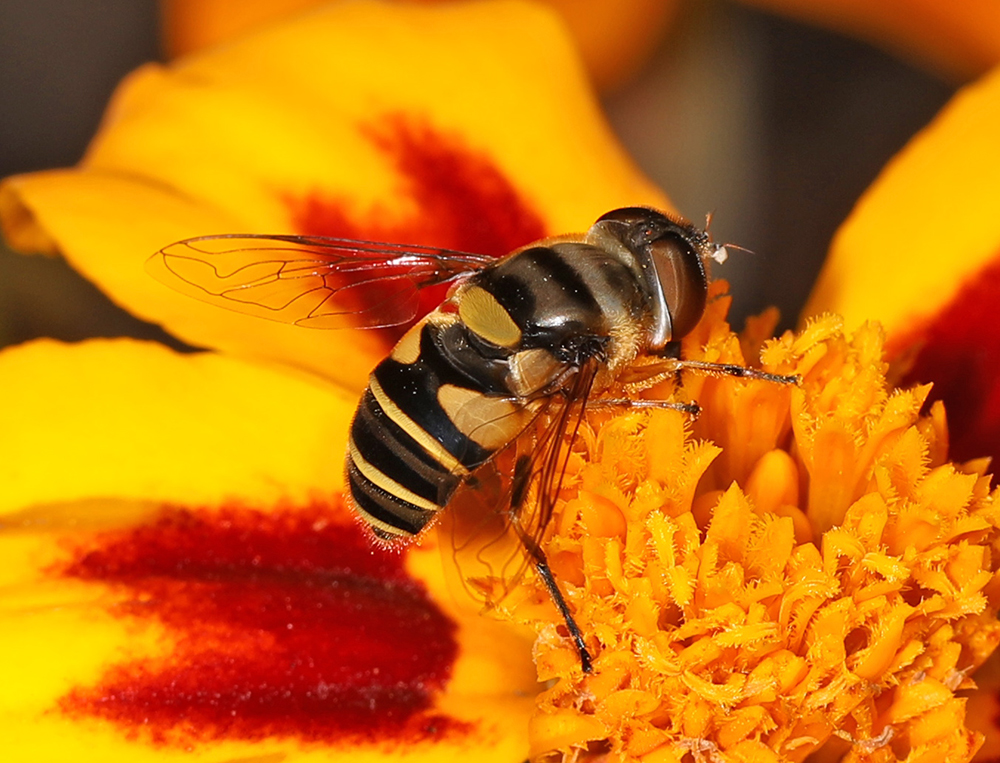
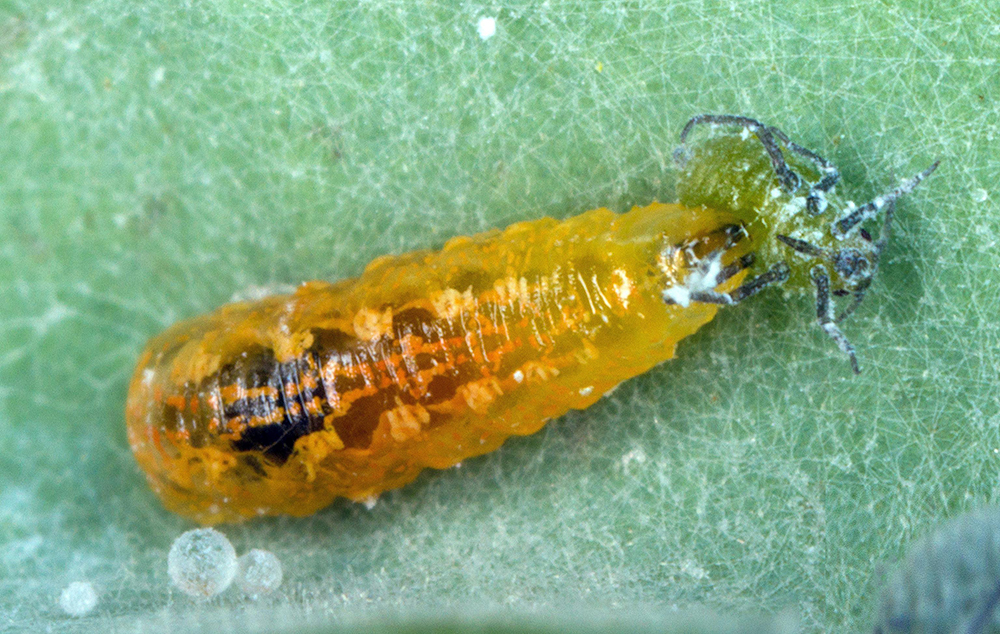
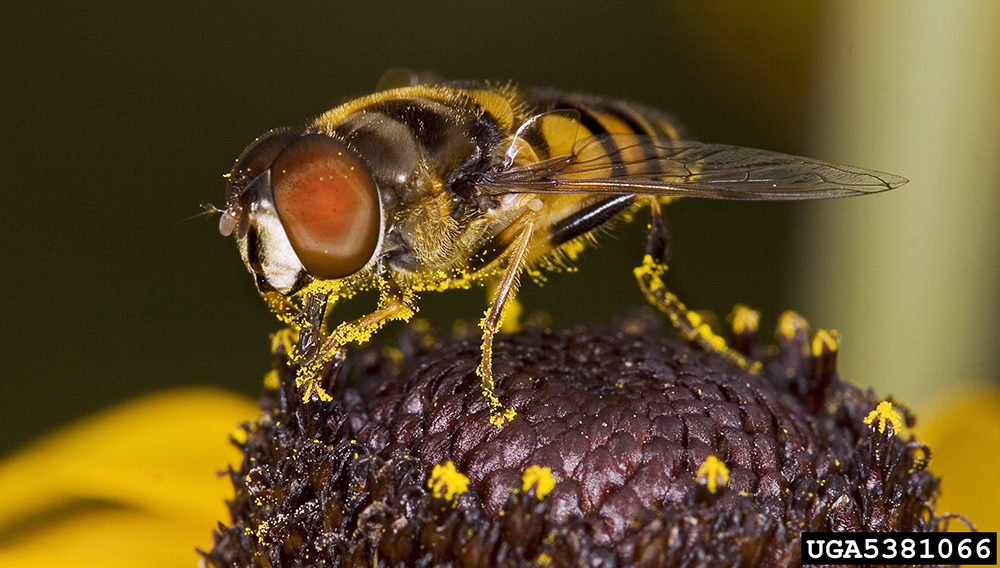
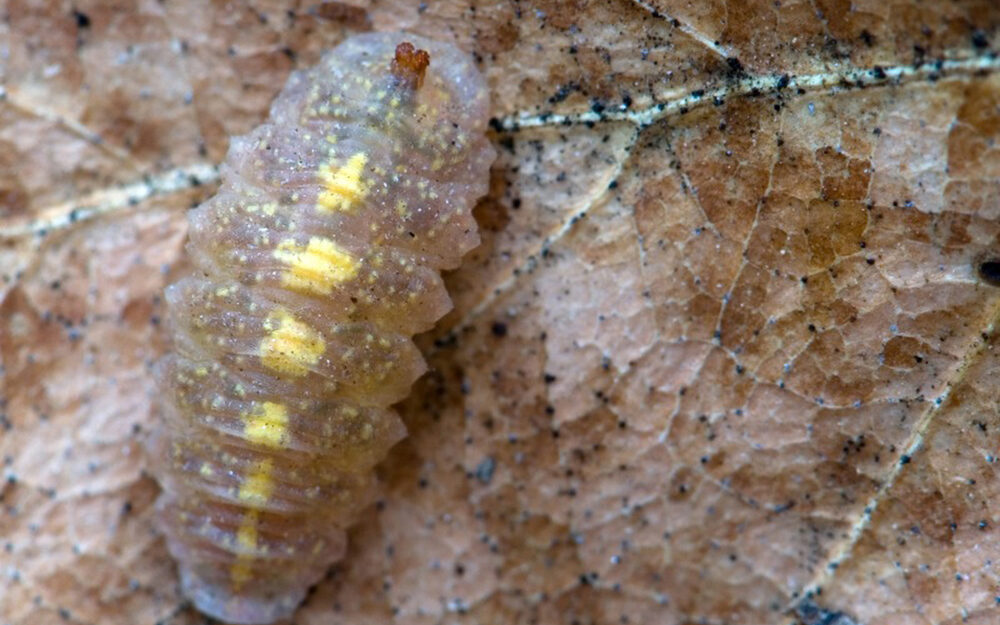
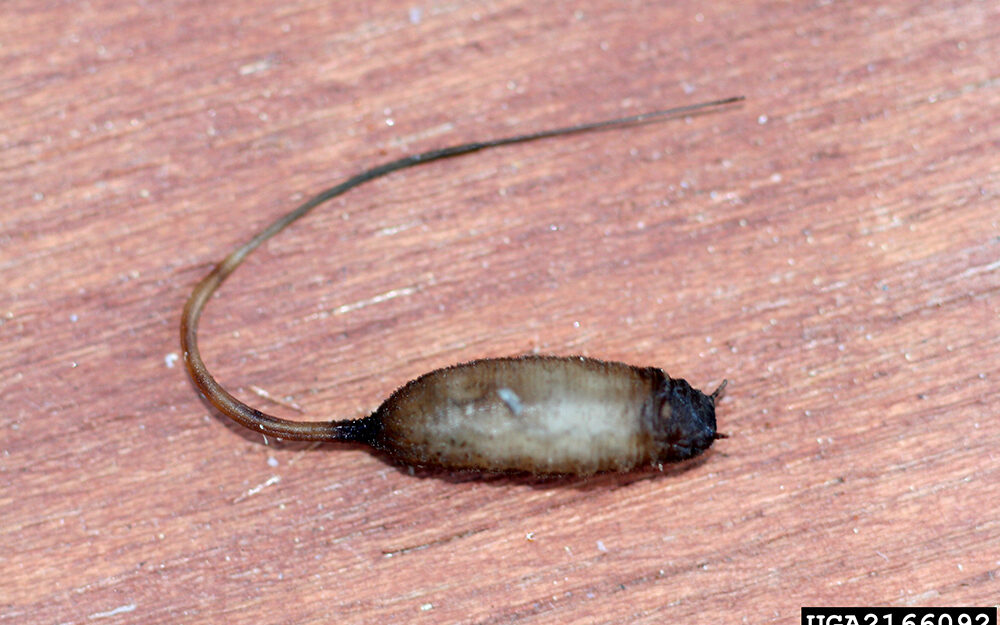
WHERE THEY ARE FOUND: Flower fly larvae are found in ant mounds, leaf litter and rotting wood, or on plants. Adults can be found in habitats with abundant flowering plants. Flower flies are less common in arid areas.
WHAT THEY EAT: Larvae in the soil consume decaying vegetation or wet wood. Predatory larvae in the soil hunt soil insects, especially social insects like ants and termites. Adults visit flowers, where they drink nectar and occasionally eat pollen.
LIFE CYCLE: Flower flies lay eggs singly or in small clumps on foliage near larval food sources. Flower flies overwinter in leaf litter or soil as larvae, pupae, or adults. There can be one or multiple generations in a year (it varies with species).
APPROX. NUMBER OF KNOWN SPECIES: 6,000 worldwide (900 in North America).
RELATIVE ABUNDANCE: Many species can be abundant.
NOTES OF INTEREST:
- Adults hover at flowers, earning another common name, hover flies.
- Many aboveground species are important predators of crop pests like aphids and scales.
- Ant predators use chemical mimicry to avoid detection within ant nests; they produce a substance on their exoskeleton that is very similar to a substance produced by ants.
- Conservation strategies include protecting permanent habitat such as grasslands, meadows, field borders, and hedgerows. Since flower flies are less active under windy conditions, windbreaks may provide shelter and increase populations. Limit tilling, which may destroy overwintering sites.
- Some species are associated with fens, wetlands, bogs, and swamps, where the larvae feed on rotting wood or vegetation.
- Flower fly larvae have diverse feeding styles, and some are important filter feeders in water (e.g., Eristalis spp.).
This material is based upon work that is supported by the National Institute of Food and Agriculture, U.S. Department of Agriculture through the Sustainable Agriculture Research and Education (SARE) program. Any opinions, findings, conclusions, or recommendations expressed in this publication are those of the author(s) and should not be construed to represent any official USDA or U.S. Government determination or policy.
